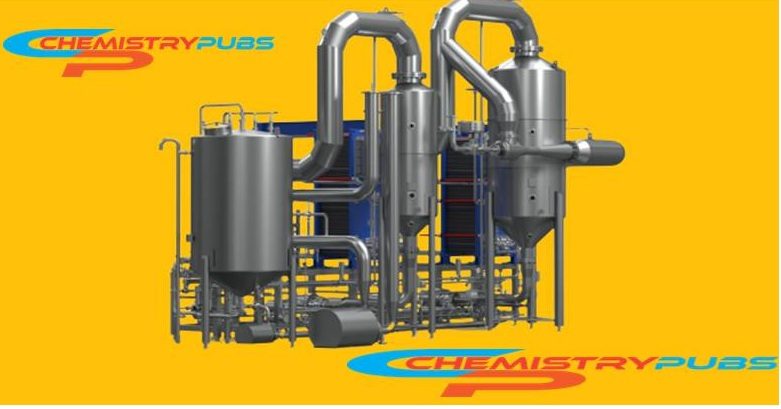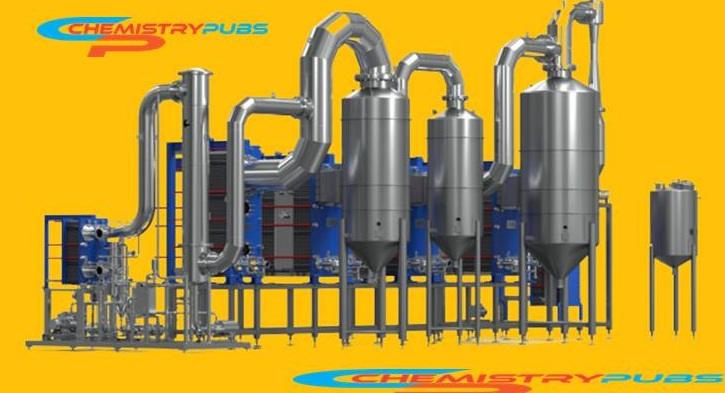An evaporator is one type of cooling or refrigerant system. Heat can be absorbed by this system from the space or surrounding medium to be cooled or refrigerated is done by this equipment. This important instrument has different shapes, types, and designs to perform various nature of cooling requirements. There exist various types of this equipment namely prime surface types, finned tube or extended surface types, shell, and tube liquid chillers, etc. This instrument needs to concentrate aqueous liquids as well as concentrate thermostable liquors. [1]
Types of Evaporator:
There are mainly three types of this equipment are found which discussion is given below:
Flooded type
The feed of the flooded-type evaporator is in excess of liquid refrigerant so the exit of the evaporator will be a mixture of liquid and vapor refrigerant components. The coil of this evaporator is generally filled with liquid refrigerant. The liquid refrigerant level in this evaporator is maintained constantly in the surge chamber by using float control.
The refrigerant liquid enters into this evaporator coil from the surge chamber and the remaining refrigerant is come back to the surge chamber. Then the refrigerant vapors are transferred in the suction line of the compressor. It can possible heat transfer easily by this equipment but it requires a large amount of refrigerant. This type is very suitable for large installations where refrigerating capacity is high. It is very important for a refrigeration system where load fluctuation is higher.
Finned type
This type of evaporator consists of a bare tube covered with fins. A lot amount of cooling effect from the refrigerant goes wasted at the time of flowing the fluid which is to be chilled. The less heat transfer from the fluid to the refrigerant occurs at that time. The bare tube evaporators are not very effective because the fluid of this equipment wants to move between the open spaces of the tubing and does not come in contact with the surface of the coil.
The contact surface can be increased in the fins on the external surface of the bare tube evaporators which come in contact surface of the metallic tubing with the fluid and increase the heat transfer rate. So it can be said that this type is more effective than the bare tube evaporators. The finned types are very suitable for use in air conditioners of almost all types like window, packaged, split, and central air conditioning purposes. [2]
Structure of the Evaporator
It consists of the refrigerant system which helps to evaporate quickly the liquid system. A cooling system is also found in this process which helps to transfer heat and take in a high yield. Boiling refrigerant can take up the heat from the air and is carried in the system to the condenser. The inlet and outlet pressure difference by refrigerant should be designed in a manner to keep to a minimum.
A proper heat transfer and more easily wetted inner and outer surfaces of the necessary conditions for good evaporation increases the pressure loss of this situation. So it should be remembered that extensive experience and attention evaporator design should be kept to the way of working is often referred to as a trial. [3]

Working Principle
It works when the air conditioning system is turned on. Warm air firstly passes through the coils and fins of the evaporator from the passenger compartment. It then receives the refrigerant from the thermostatic expansion valve as a low-pressure, cold atomized liquid. Heat is removed from the warm air into the cooler refrigerant when the cold refrigerant goes through the coil. The low-pressure liquid turns into a low-pressure vapor after receiving enough heat from the refrigerant liquid.
The thermostatic expansion valve or orifice tube helps to calculate the definite amount of refrigerant necessary for maintaining optimum heat transfer, which helps to ensure that all of the liquid refrigerants will have changed to a vapor state by the time it reaches the outlet place. Finally, the vaporized refrigerant is then found on the suction side of the compressor. [4]
Factors choosing
There have many factors which should be remembered to install this equipment:
It should have good heat transfer facilities by using a minimum surface area
It should have a good ability to segregate vapor from the liquid concentrate effectively
It must be proper for products that are being processed
It should have the ability to produce the right product
It must be built with materials to minimize corrosion.
Applications of Evaporator
This equipment has versatile applications for its structure. It is a very important common piece of equipment for processing industries. It can be seen in various food and dairy products industries for processing such as tomato purees, milk, herbal extracts, gelatin, coconut water, and whey and milk proteins which are all processed with the help of evaporators. It is also true for various chemical processing such as dyes, ammonium nitrate, glycerin, sodium nitrate, paints, and pigments.
They are very essential for very low-temperature applications in the food and pharmaceutical industries. It is important apparatus for the good production of plasma, coffee extracts, fruit juices, bulk drugs, fermented products, glycerin, sweet water, yeast extract, and protein hydrolysate. There have many items such as whey, gelatin, glucose, fructose, dextrose, malt extracts, sorbitol, and maltodextrin are all produced with evaporators, as well.
This instrument is very suitable for waste management for treating effluents, or wastewater, from various plants, including distilleries, grain mills, abattoirs, textile plants, chemical reactors, and storage tanks. Evaporators are used to purify natural oils, fatty acids, herbicides, and insecticides.
References
1.https://www.sciencedirect.com/topics/agricultural-and-biological-sciences/evaporators
2.https://www.oercommons.org/authoring/57346-types-of-evaporator/view
3.https://learnmech.com/evaporator-types/
4.https://www.tesisat.org/en/evaporator-types-and-principle-of-operation.html

